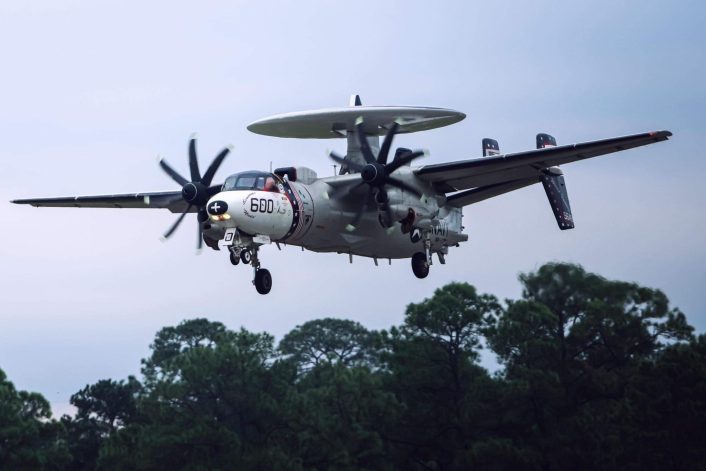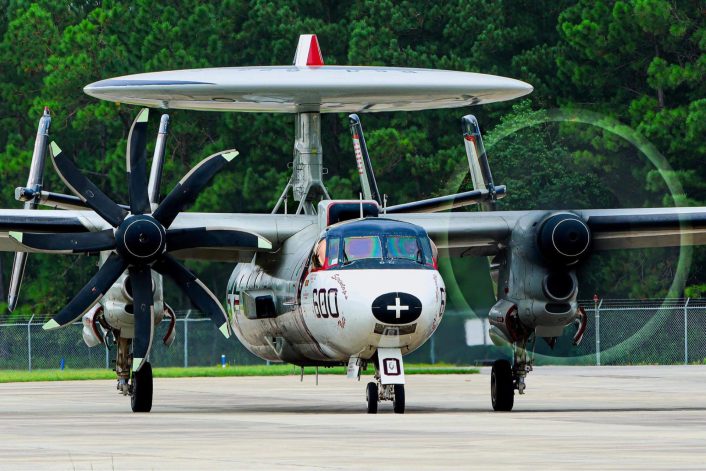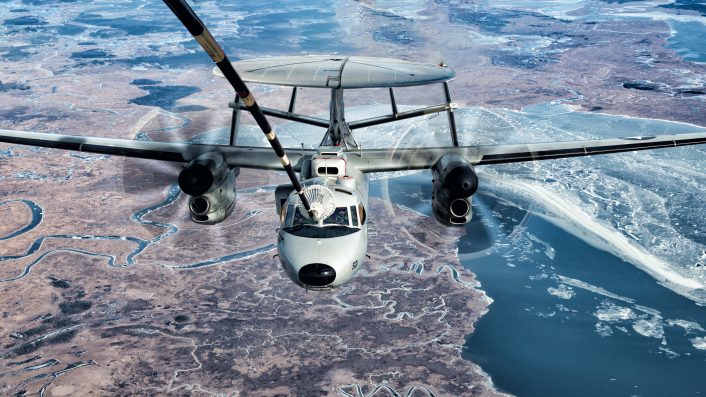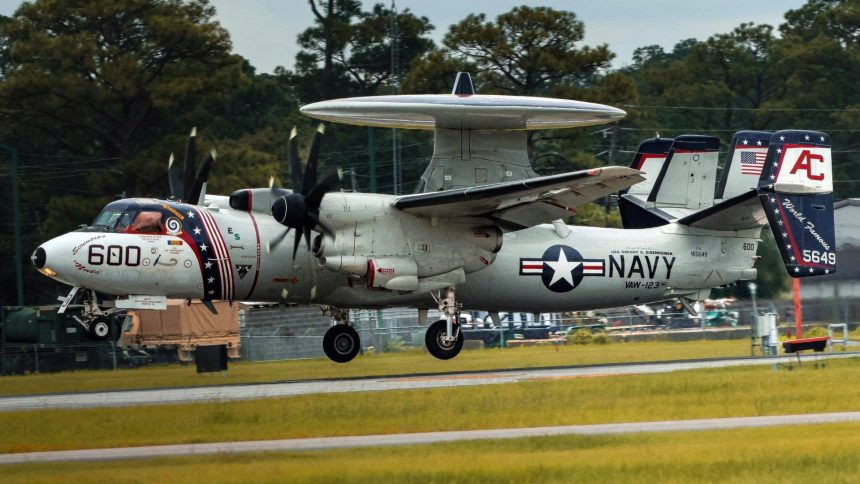Airborne Command and Control Squadron 123 “Screwtops” have retired the E-2C to continue transition to the E-2D Advanced Hawkeye.
VAW-123 sent two of its four remaining E-2C Hawkeye AEW&C (Airborne Early Warning & Control) aircraft to the “Boneyard” at Davis-Monthan Air Force Base in Tucson, the largest aircraft storage and preservation facility in the world, on Sept. 9, 2024. This transfer is part of the squadron’s transition to the upgraded E-2D Advanced Hawkeye, which is set to complete by mid-2025, a public release by the Commander, Naval Air Force Atlantic, said.
The other two E-2C Hawkeyes from VAW-123 were reassigned to VAW-120, the Fleet Replacement Squadron, to help train the next wave of Hawkeye aviators.
Lieutenant Terrance Lawrence, a pilot with VAW-123, was among those chosen to fly an E-2C on its final journey to the 309th Aerospace Maintenance and Regeneration Group (AMARG) at Davis-Monthan AFB, Arizona. For more than 50 years, the E-2C has served as the backbone of the Navy’s command and control missions. VAW-123 has operated the E-2C since 1973, and over the years, this platform has been used in military operations, search and rescue, drug enforcement, humanitarian missions, and disaster relief.

This was Lawrence’s first time delivering an aircraft to retirement, and he appreciated the unique opportunity:
It was a rare chance—this isn’t something many aviators get to do. It was a special moment, and I signed up right away.
Lieutenant Avesta Shwany, another VAW-123 pilot, flew the second E-2C to the boneyard, reflecting on her crew’s bittersweet departure from Norfolk.
Being part of the last crew was incredibly emotional. This aircraft has so many memories, especially from our recent deployment to the Red Sea.
For Shwany and the crew, saying goodbye to this iconic aircraft marked the close of an era and the start of their transition to the E-2D.
It surprised us all how emotional it was to leave her behind” Shwany added.
Lawrence expressed pride in being the last pilot to fly the E-2C for VAW-123. As a tribute, he and the crew signed the aircraft’s interior as a farewell. “This plane meant a lot, especially after those nine months in the Red Sea,” he said.
Before handing over the aircraft at Davis-Monthan, the crew of 10 took a moment to tap the side of the aircraft in a final gesture of farewell. The squadron also took time to tour the boneyard, which houses over 4,000 aircraft, immersing themselves in aviation history. “It’s an honor to be one of the last pilots in this aircraft’s story,” Lawrence reflected.
With VAW-123 progressing to the E-2D, the Navy’s west-coast VAW-116 now remains the last fleet squadron flying the E-2C until its planned retirement. Lawrence, for his part, is looking forward to piloting the E-2D.

E-2D Advanced Hawkeye
The E-2D Advanced Hawkeye (AHE) represents the latest evolution in the E-2 series, which has been the backbone of U.S. Navy’s airborne early warning and battle management capabilities for decades. This next-generation model brings a suite of advanced upgrades, making it far more capable and versatile than its predecessors, with improvements designed to ensure it meets the needs of modern warfare.
At the core of the E-2D is a state-of-the-art radar that offers what the Navy describes as a “two-generation leap” in capability over previous models. This advanced radar system dramatically increases detection range, target resolution, and tracking accuracy. The radar improvements, combined with other system upgrades, allow the E-2D to cover vast areas both at sea and over land, enhancing situational awareness for the fleet. The platform’s extended range and overland capabilities mean it can operate effectively in littoral regions, providing critical coverage in complex environments, where threats can emerge from multiple domains. This broader detection and tracking range is crucial for protecting the fleet and defending U.S. interests.
What makes the E-2D particularly valuable is its role as a “digital quarterback” of the skies. Unlike earlier models, the E-2D goes beyond simply relaying information, functioning as a highly integrated command and control node. This makes it essential in managing diverse, concurrent missions, whether directing airborne strike operations, coordinating with ground forces, supporting search and rescue efforts, or serving as a communications hub across a dispersed fleet. The Hawkeye’s multi-mission capabilities have proven critical in operations such as drug interdiction, where coordinating between multiple agencies and assets is essential.
A key innovation in the E-2D is the fully integrated “glass cockpit” and the addition of a tactical fourth operator display, which offers the five-person crew more flexibility. With two pilots and three mission systems operators, plus the option for the co-pilot to act as a fourth systems operator, the crew can dynamically adapt to mission needs in real-time, maximizing the platform’s multi-mission potential.
A significant milestone for the E-2D program is its recent integration of aerial refueling capabilities. Achieving Initial Operational Capability (IOC) in fiscal year 2020, the aerial refueling upgrade transforms the E-2D’s operational profile by greatly extending its time on station. With aerial refueling, the Hawkeye can stay airborne almost indefinitely, limited primarily by crew and airframe endurance. This extended range allows for more persistent surveillance and command and control operations, enabling it to cover broader areas and support longer missions. The refueling-equipped E-2D AHE models also feature several structural and ergonomic upgrades, such as endurance seats, enhanced fuel systems, and new exterior lighting to facilitate night operations.

In terms of specifications, the E-2D boasts an overall length of 57 feet, 8.75 inches, a wingspan of 80 feet, 7 inches, and is powered by two Rolls-Royce T56-A-427A turboprop engines, each generating 5,100 horsepower. With a maximum speed exceeding 300 knots and an operational ceiling of 37,000 feet, the E-2D can reach high-altitude vantage points quickly and effectively.
As the “eyes of the fleet,” the E-2D Advanced Hawkeye ensures that the U.S. Navy remains ready for the challenges of modern warfare, whether by coordinating complex operations across the fleet or providing a critical early warning and defense capability against ever-evolving threats. With Northrop Grumman as the prime contractor, the E-2D promises to continue the legacy of the Hawkeye platform while setting new standards for airborne command and control in naval aviation.









